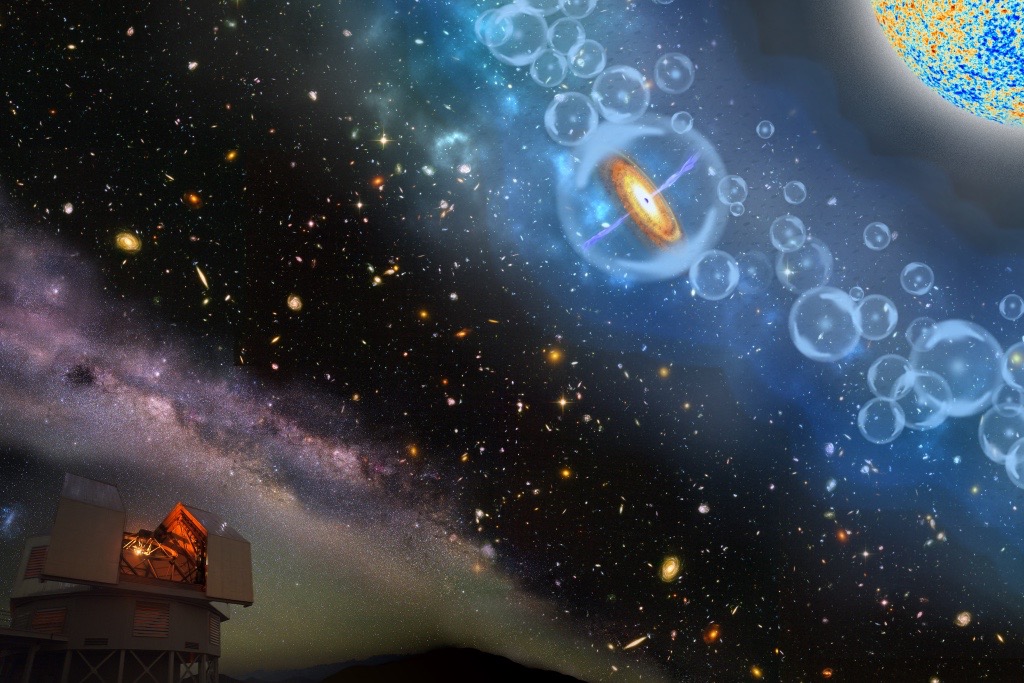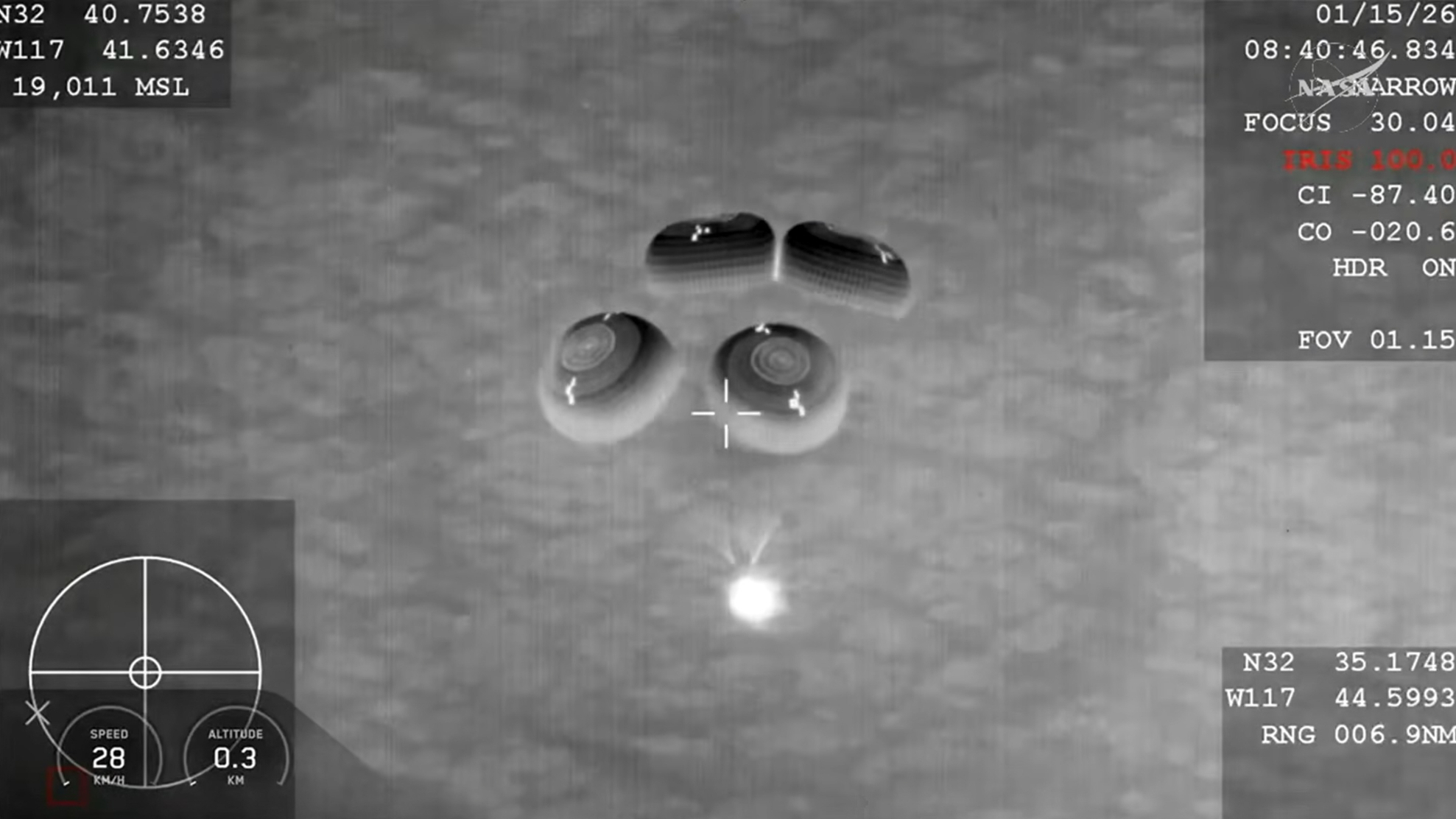Oldest Monster Black Hole Ever Found Is 800 Million Times More Massive Than the Sun

Astronomers have discovered the oldest supermassive black hole ever found — a behemoth that grew to 800 million times the mass of the sun when the universe was just 5 percent of its current age, a new study finds.
This newfound giant black hole, which formed just 690 million years after the Big Bang, could one day help shed light on a number of cosmic mysteries, such as how black holes could have reached gargantuan sizes quickly after the Big Bang and how the universe got cleared of the murky fog that once filled the entire cosmos, the researchers said in the new study.
Supermassive black holes with masses millions to billions of times that of the sun are thought to lurk at the hearts of most, if not all, galaxies. Previous research suggested these giants release extraordinarily large amounts of light when they rip apart stars and devour matter, and likely are the driving force behind quasars, which are among the brightest objects in the universe. [The Strangest Black Holes in the Universe]
Astronomers can detect quasars from the farthest corners of the cosmos, making quasars among the most distant objects known. The farthest quasars are also the earliest known quasars — the more distant one is, the more time its light took to reach Earth.
The previous record for the earliest, most distant quasar was set by ULAS J1120+0641. That quasar is located 13.04 billion light-years from Earth and existed about 750 million years after the Big Bang. The newfound quasar (and its black hole), named ULAS J1342+0928, is 13.1 billion light-years away.
How black-hole monsters grow
Explaining how black holes could have gobbled up enough matter to reach supermassive sizes early in cosmic history has proved extraordinarily challenging for scientists. As such, researchers want to look at as many early supermassive black holes as possible to learn more about their growth and their effects on the rest of the cosmos.
"The most distant quasars can provide key insights to outstanding questions in astrophysics," said study lead author Eduardo Bañados, an astrophysicist at the Carnegie Institution for Science.
Breaking space news, the latest updates on rocket launches, skywatching events and more!
The researchers predicted that only 20 to 100 quasars as bright and as distant as the newfound quasar exist in the whole sky visible from Earth.
"This particular quasar is so bright that it will become a gold mine for follow-up studies and will be a crucial laboratory to study the early universe," Bañados told Space.com. "We have already secured observations for this object with a number of the most powerful telescopes in the world. More surprises may arise."
Finding a behemoth
The researchers detected and analyzed quasar ULAS J1342+0928 using one of the Magellan Telescopes at Las Campanas Observatory in Chile, as well as the Large Binocular Telescope in Arizona and the Gemini North telescope in Hawaii. Its central black hole has a mass about 800 million times that of the sun and existed when the universe was just 690 million years old, or just 5 percent of its current age. [No Escape: The Anatomy of a Black Hole (Infographic)]
"All that mass — almost 1 billion times the mass of the sun — needs to be gathered in less than 690 million years," Bañados said. "That is extremely difficult to achieve and is something that theorists will need to explain in their models."
Quasars like J1342+0928 are rare. The researchers searched one-tenth of the entire sky visible from Earth and found just one quasar from this early epoch.
Only about 60 million years separate this newfound quasar from the previous record holder. Still, this span of time was "about 10 percent of the age of the universe at those early cosmic epochs, when things were evolving very rapidly," Bañados said. That means this difference in time could yield important clues about the evolution of the early universe.
This new quasar is also of interest to scientists because it comes from a time known as "the epoch of reionization," when the universe emerged from its dark ages. "It was the universe's last major transition and one of the current frontiers of astrophysics," Bañados said in a statement.
Right after the Big Bang, the universe was a rapidly expanding hot soup of ions, or electrically charged particles. About 380,000 years later, these ions cooled and coalesced into neutral hydrogen gas. The universe stayed dark until gravity pulled matter together into the first stars. The intense ultraviolet light from this era caused this murky neutral hydrogen to get excited and ionize, or gain electric charge, and the gas has remained in that state since that time. Once the universe became reionized, light could travel freely through space.
Glimpsing the early universe
Much remains unknown about the epoch of reionization, such as what sources of light caused reionization. Some prior work suggested that massive stars were mostly responsible for reionization, but other research hinted that black holes were a significant, and potentially dominant, culprit behind this event. [7 Surprising Things About the Universe]
"How and when the reionization of the universe occurred has fundamental implications on how the universe evolved," Bañados said.
The new findings revealed that a large fraction of the hydrogen in the immediate vicinity of the newfound quasar was neutrally charged. This suggests that this quasar comes from well within the epoch of reionization, and further analysis of it could yield insight into what happened during this pivotal time.
However, to really learn more about the epoch of reionization, scientists need more than just one or two early, distant quasars to look at. "We need to find more of these quasars at similar or larger distances," Bañados said. "This is extremely difficult, as they are very rare. This is really like finding the needle in a haystack."
Still, the fact that this newfound quasar is so bright and large suggests that "it's probably not the first quasar ever formed, so we need to keep searching," Bañados said.
The scientists detailed their findings in the Dec. 7 issue of the journal Nature. The researchers also released a companion paper in The Astrophysical Journal Letters.
Follow Charles Q. Choi on Twitter @cqchoi. Follow us @Spacedotcom, Facebookand Google+. Original article on Space.com.

Charles Q. Choi is a contributing writer for Space.com and Live Science. He covers all things human origins and astronomy as well as physics, animals and general science topics. Charles has a Master of Arts degree from the University of Missouri-Columbia, School of Journalism and a Bachelor of Arts degree from the University of South Florida. Charles has visited every continent on Earth, drinking rancid yak butter tea in Lhasa, snorkeling with sea lions in the Galapagos and even climbing an iceberg in Antarctica. Visit him at http://www.sciwriter.us


